CONVEX HULL ALGORITHMS
Definition: The convex hull of a planar set is the
minimum area convex polygon containing the planar set.

Consider
set of points S = { xi yi}
i
= 1, 2,
, n
NOTE: For a point (x, y) to be a VERTEX (i.e on
the convex hull) the exterior angle formed by joining (x, y) to its immediate
neighboring vertices must be > 180o (p)
3 CONVEX HULL ALGORTIHMS
I. R. L. Graham (1972)
Information Processing Letters V1, p132-133
II. R. A. Jarvis (1973)
..
V2,
p18-21
III. S. G.
Akl and G. T. Toussant (1978)
.
.V7,
p219-222
I.
Grahams Algorithm

Step 1: Find the bottommost point P
T = c1n
Step
2: Express each (xi, yi)
Ξ S in polar
coordinates with origin P and f = 0 in the direction of R T = c2n
Step
3: Order the elements rkeifk of S in terms
of increasing fk to give:
S = { r1eif1, r2eif2,
, rneifn}
T = c3n
log n
Step
4: Consider 3 consecutive points in S

2
possibilities:
(i) a + b ³ p Delete
point (k + 1) from S and
return to step 4 with
points
(k - 1), k , (k
+ 2)
(ii) a + b < p Return to step 4 with points
(k + 1), (k
+ 2), (k + 3)
Step 4 either reduces
number of possible points of CH(S) by one
or increases
the total of S points
considered by one
T(n) < 2 n
Total
T(n) = k1n + c3n log n
II Jarvis Algorithm

Step
1: Find an origin point outside the set
S
e.g. x0 £ min { xi } y0 £ min { yi }
T = c1n
Step
2: Find (xk, yk)
such that
q0k £ min { q0i } i = 1, 2,
, n
where q0i is the angle measured with
respect to a horizontal axis
through
(x0, y0)
Step
3: Shift origin to (xk, yk)
and repeat step 2
with consistent angle direction
and
origin until 1st convex
hull point is
re-found
T = (m + 1)n
for m convex hull points
Improvements
(1) Point Deletion
After step 2 has been completed once and 1st
CH point identified, evaluate and store the angles of lines from the 1st
CH point to the (n 1) other points.
Then within step 2 after the 1st iteration, any point whose
angle calculated and stored is < the last found CH point cannot be a valid
candidate for a CH point.

Example n = 29 m = 9
n(m
+ 1) = 290
(2) Obviating actual angle evaluation
opposite side adjacent side

[Keep
a list of for the
right-angled Ds]
(i) check the signs of (xi x0)
and (yi y0)
(i=1,2,
, n) to determine the quadrant
opp. side for quadrants adj.
side 1 & 3 inverse 2
& 4)
(ii)
keep only the lowest ratio (
for the lowest quadrant yet detected when
working through the points.
III AKL and TOUSSANT algorithm

Vector cross product

C =
a b sin q = a b sin (a1 + a2)
=
(yk+1 yk) (xk+2
xk+1) + (xk xk+1)
(yk+2 yk+1)
C
L.
H. diagram R.H.
diagram + ve - ve
If
C ³ 0 keep point (k + 1) else delete it
Step
1: Find the extremal points and delete
all
other points falling inside the
polygon
they form. T = c1n
Step
2: Sort the remaining points on their x
co-ordinate: in ascending order
for
regions 1 & 2 and decreasing
order for
regions 3 & 4. T = ε ci ni
log ni
Step
3: For each region find the convex path
from one extremal point to
the next
Generally for every 3
consecutive points
k, k + 1, k + 2
(i)
Compute
C
(ii)
If
C ³ 0 move 1 point forward
else delete point (k + 1) and move
1 point backward.
T = ε ci ni
Advantages
(i) For large n approximately ½ the
points are
discarded in Step 1
(ii) Breaking the problem into sub-problems by
distributing the points into the
different
regions makes it easier and faster to solve
(good example of DIVIDE & CONQUER)
(iii) The cross product criterion is simple and
inexpensive compared to computation
of
angles, shifting the axes.
Timings
for 100 runs in seconds
|
Uniform
Within |
250 |
500 |
1000 |
2000 |
||
|
I |
1.18 |
2.39 |
4.78 |
9.78 |
||
|
II |
2.62 |
6.02 |
13.21 |
29.02 |
||
|
III |
0.91 |
1.73 |
3.37 |
6.54 |
|
Uniform
Within |
250 |
500 |
1000 |
2000 |
||
|
I |
1.17 |
2.24 |
4.69 |
9.44 |
||
|
II |
6.65 |
16.37 |
52.63 |
104.86 |
||
|
III |
2.05 |
4.35 |
9.50 |
20.74 |
|
|
250 |
500 |
1000 |
2000 |
||
|
I |
1.01 |
2.01 |
4.02 |
8.16 |
||
|
II |
42.5 |
164 |
674 |
2615 |
||
|
III |
2.3 |
4.82 |
10.28 |
21.60 |
Problems
in computational geometry related to the convex hull
Given a set of N points in the plane determine:
(i)
the
rectangle of minimum area which will completely cover (or encase) the set (MER)
(ii)
the
diameter of the set (the 2 points which are furthest apart)
(iii)
the
shortest tour which will visit each point once and return to the starting point
(the classical Traveling Salesman Problem)
Problems (i) and (ii) may be solved by a common
technique: the HIGHPOINT
STRATEGY
This leads to efficient algorithms for both problems
because all highpoints can be found in O(n) time.
Highpoint Strategy
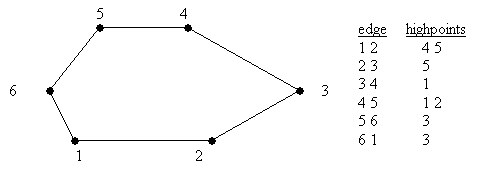 Given a convex polygon, determine the vertex point(s) which has
(have) the greatest perpendicular distance above each edge.
Given a convex polygon, determine the vertex point(s) which has
(have) the greatest perpendicular distance above each edge.
Algorithm for highest points
1.
Locate
the highest point(s) above an initial edge i j of the polygon
2.
(Highpoint
strategy) move to the next edge, let i
= j, j = cclock(i), and find its highest point(s). Start the scan at the highpoint from the previous edge (or left
highpoint if there are 2). Repeat step
2 until initial edge is reached.
Question: Find the MINIMUM
ENCASING RECTANGLE for a
set of N points in the plane

The Minimum Encasing
Rectangle
Theorem: (Freeman and Shapira) The minimum area encasing rectangle of a convex polygon must have one side collinear with an edge of the polygon.
Algorithm:
Step 1: Compute the
convex hull of the set
Step 2: Compute the encasing rectangle
collinear to each edge and
take
smallest as MER
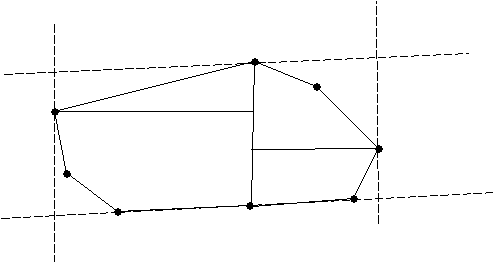
Area of encasing rectangle collinear to edge i j is
l * (w1 + w2)
Strategy:
1. Move to next edge. Let i = j, j = cclock(j)
To find new highpoints A, D, and B; use
the
previously determined highpoints as
the
starting points for the new highpoint
scans.
Compute the NEWAREA.
2.
Apply process to each edge.
Average
time to find MER for uniform random points on the boundary of ellipse
|
N |
Time
(for 100 runs in secs) |
|
|
125 |
3.556 |
(.0114) |
|
250 |
7.096 |
(.0344) |
|
500 |
14.184 |
(.0532) |
|
1000 |
28.116 |
(.0729) |
(ii) The Diameter of a Set
N =
N(N-1) ~ O(N2) 2
2
One
possibility: Examine the distance between
all possible pairs of points
Theorem: (Hocking) The diameter of
a set
must be realized by 2 points on its convex
hull.
Theorem: (Yaglon) The diameter of
a
convex polygon is the greatest distance
between parallel lines of support.
Definition: A line L is a line of support of a
polygon P if it meets the boundary of P and
P lies entirely on one side of L.

L
supports P, M and N do not.
Two
lines of support parallel to a given direction
Algorithm
DIAM
1: Find the convex hull of the set
T(n) ~ O(n
log n)
2: Enumerate all pairs of vertices for which
parallel lines of support exist (referred
to by
M. I. SHAMOS as antipodal pairs) and take
the pair separated by the largest distance.
Assuming N points are on the hull, step 2 may
be computed in O(N) time by applying the HIGHPOINT strategy and the following
observation:
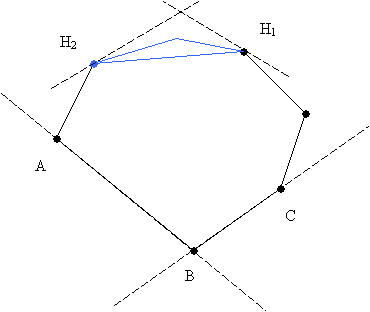
In the figure AB and BC are the lines of support
of vertex B. Let the highest points
above these two lines be H1 and H2 respectively. Because of the convexity property of the
hull, parallel lines of support to AB and BC can pass through H1 and
H2. Thus (B, H1)
and (B, H2) are antipodal pairs. Only the chain of points on the convex hull between H1
and H2 will admit to parallel lines of support in conjunction with
point B (blue triangle).
Algorithm
DIAM
1: Start with the bottom most point i on
the hull and its two common edges. Find
the highest point above each edge.
Label these points H1 and H2. Compute the interpoint distances between i
and all vertices in the chain H1
H2. Keep only the largest of these distances L
and its corresponding antipodal pair (i, Hi) where Hi
is the farthest point from i.
2: Let i = cclock(i). Find the highest point above each edge
adjoining i. Set H1 =
H2 (or H1= clock(H2) if two highpoints) and
use the HIGHPOINT strategy to find H2. Compute distances between i and all vertices in the chain
H1
H2. As the
values are computed, compare with the largest pair already in storage, and if
necessary, reassign L and the corresponding pair. Repeat step 2 until i = Hi
Why stop at Hi?
Performance
of DIAM
For
uniform random points generated on the boundary of an ellipse
For
each sample size all points remained on the hull. 5 tests of 100 runs were carried out for each sample size
|
N |
DIAM |
SHAMOS
Algorithm |
|
125 |
.466
(.0089) |
.698
(.0048) |
|
250 |
.926
(.0152) |
1.432
(.0164) |
|
500 |
1.832
(.0130) |
2.886
(.0207) |
|
1000 |
3.644
(.0462) |
5.810
(.0678) |
|
2000 |
6.990
(.0914) |
11.762
(.1180) |
times in seconds for 100 runs
(iii) The Euclidean Traveling Salesman
Problem
Known
results (enumeration is O(NN)!)
1. The shortest tour cannot intersect itself
2. The order in which the points of S forming
the vertices of the convex hull appear in the
shortest tour is the same as the order in
which they appear along the boundary of the
convex hull.

Procedure
HULL_HEURISTIC (S, n, Tm)
BEGIN
Step 1:
Form the convex hull of S. Let m
=
number of points on the hull
and let the
hull be initial subtour Tn.
Step 2:
WHILE m < n DO
BEGIN {insertion phase}
Step 3: For each point k
not yet
contained in Tm
find two
consecutive points i,
j Ξ Tm on the
subtour such that d2(i,
k) + d2(k, j)
d2(i, j) is
minimal.
Step 4: From
all the (i, j, k) found in
step 3
determine the (i*, j*, k*)
such
that [d2(i*,k*)
+ d2(k*,j*)]/ d2(i*,j*)
is
minimal
Step 5: Let
Tm+1 = Tm + k*
{insertion
of k* into
Tm between node i* and j*}
Step 6: m = m
+ 1
END {WHILE loop}
END
{Hull_Heuristic Tm contains ETSP tour}
Depending
on inputs, procedure takes from O(n2) to O(n3)
to compute Tn.
The
L1 Traveling Salesman Problem
(sometimes
called the Manhattan metric)
The
distance between any 2 points (xi, yi), (xj,
yj) is d1(i,j) = | xi
xj | + | yi yj |
To
find a tour of minimum distance, first compute the L1 hull, and use
it as the initial subtour. Then call a
modified PROCEDURE HULL_HEURISTIC (with distance function d1
rather than d2)

Performance
L1
TSP tested against two heuristics which have been used to solve the ETSP (L2
TSP) nearest insertion and farthest insertion.
Random
number generator used to generate points uniformly throughout the unit square
for different N.
Quality
of each algorithm measured by:
Efficiency = (length of tour)/ B where B=1.102*length of
minimum spanning tree
|
N |
Nearest Insertion |
Farthest Insertion |
Hull Heuristic |
|
25 |
1.248 |
1.238 |
1.168 |
|
50 |
1.184 |
1.200 |
1.132 |
|
100 |
1.186 |
1.192 |
1.114 |
|
200 |
1.178 |
1.181 |
1.119 |
|
400 |
1.177 |
1.181 |
1.128 |
PROBLEM 1
Given
a rectangle containing n points, find the largest subrectangle with
sides parallel to those of the original rectangle which contains none of the
given points.

Rectangle A
Points (xi,
yi) i = 1,n
Definition: A rectangle M is a RESTRICTED RECTANGLE (RR)
if:
1.
M
is completely contained in A
2.
M
contains no points (xi, yi) in its interior
3.
Each
edge of M either contains a point (xi, yi) or co-incides with an edge of A.
Lemma: The
number of RRs is bounded by O(n2) where n is the
number of points.
There are 4 types of RRs.
1. RRs in which 2 opposite edges co-incide
with edges of A
(at
most 2n + 2)
2. RRs in
which 2 adjacent edges co-incide
with
edges of A
(at
most 2n + 2)
3. RRs in
which exactly 1 edge co-incides with
an edge
of A
(at
most 4n)
4. RRs in
which each edge contains a point
(xi,yi)
in its interior.
(at
most O(n2))
If the
points are drawn randomly and independently from a rectangle A, the expected
number of RRs is O(n log n)
An
O(n2) sweep-line algorithm (Naamad, Hsu, Lee)
1. Find maximum gap in x co-ords, MGAP
MAXR = MGAP * (Yt
Yb)
2. Sort points on y co-ords in descending order
3. for i = 1 to n do
Tl = xl, Tr = xr
for j = i + 1 to n
do
if Tl < xj
< Tr then
MAXR = max (MAXR, (Tr Tl)*(Yi
Yj))
if xj > xi then
Tr = xj else Tl = xj
MAXR = max (MAXR, (Tr
Tl)*(Yi Yb))
4. for i = 1 to n do
![]() Ri = min (xr U
xj where xj > xi yj > yi)
{look }
Ri = min (xr U
xj where xj > xi yj > yi)
{look }
![]() Li = max (xl U
xj where xj < xi yj > yi)
{look }
Li = max (xl U
xj where xj < xi yj > yi)
{look }
MAXR = max (MAXR, (Ri
Li)*(Yt Yi))
{rectangles
with top as one side}
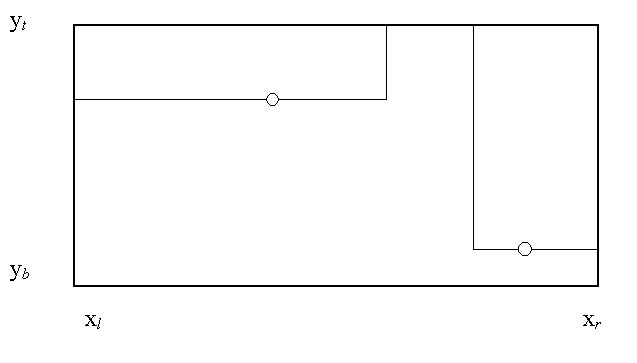
An
O(n log3 n) algorithm
(Chazelle, Drysdale, Lee)
·
used
divide-and-conquer
·
split
points into 2 halves by x co-ordinate and solve recursively
·
problem
is rectangles crossing dividing line

These rectangles have either
3 supports
in one half, 1 in other
or 2
supports in each half
Let C(n)
= time to find largest rectangle with 3
supports in one half, 1 in
other
D(n) = time to find
largest rectangle with 2
supports in each half.
T(n) £ 2T(n/2) + C(n) + D(n)
O(n) O(n log2 n)
T(n) = O(n log3 n).
PROBLEM 2
Given
a set of rectangles within a similar rectangle, find the maximum empty
rectangle which remains.
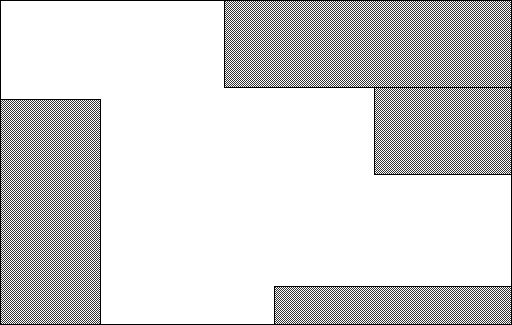
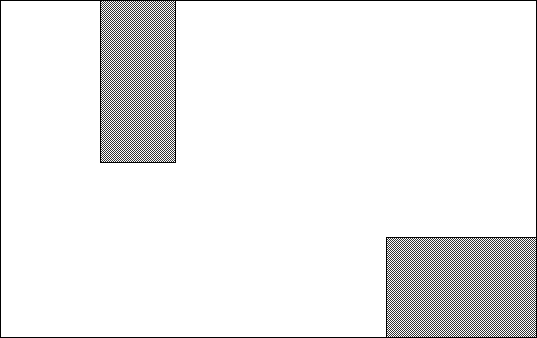

SWEEP LINE ALGORITHM
1. Set-up Edges
Horizontal Edges
(x1, x2, y, facing, x1open,
x2open)
Vertical Edges
(y1, y2, x)
2. Pre-Processing
a.
Sort
horizontal edges
b.
Sort
vertical edges
c.
Replace
downward facing horizontal edges by sweeplines
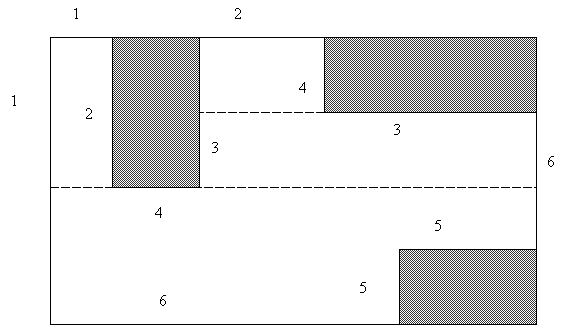
3. Sweep
Scan
horizontal edges from top and build list of downward facing edges
if edge is downward then
add to list
else {at least one rectangle
must be formed}
scan list
if overlap then
compute area of rectangle
shorten or delete downward edge

List Rectangles
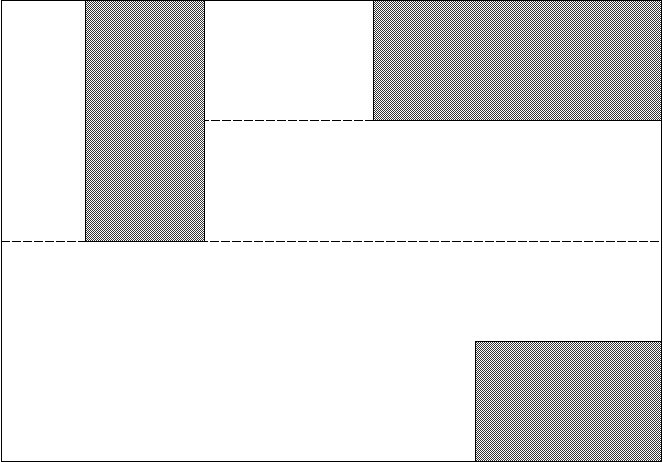
Worst
Case n = #
horizontal edges
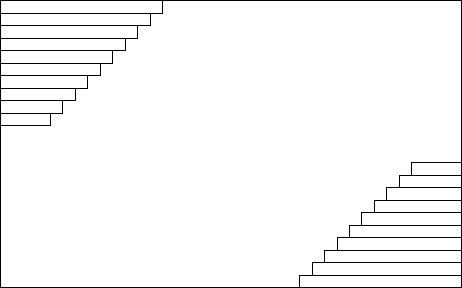
#
Rectangles = Ό n2
Best Case

#
Rectangles = n + 1
Strategy
for Placement
(i)
in
adjacent corners
(ii)
 side by side
side by side